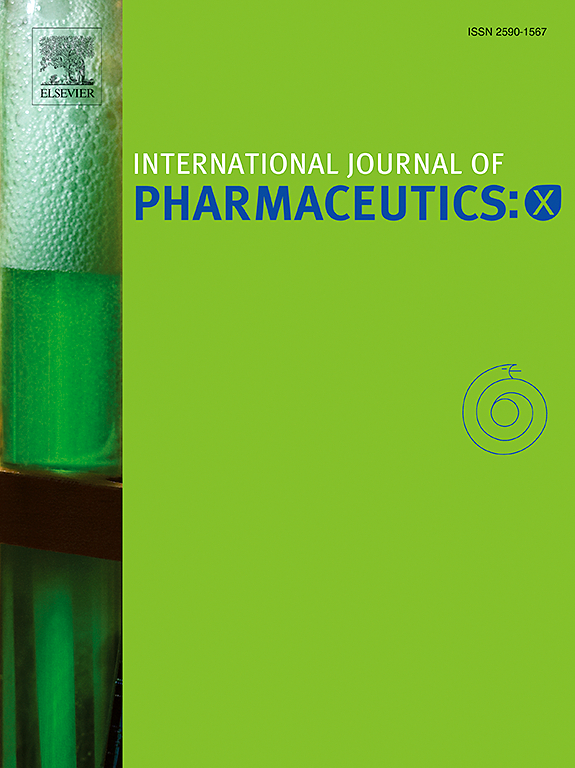Electrospinning of animal-free derived collagen-like protein: Development and characterization of VECOLLAN®- nanofibers for biomedical applications
IF 6.4
2区 医学
Q1 PHARMACOLOGY & PHARMACY
引用次数: 0
Abstract
This study investigates the potential of VECOLLAN®, a recombinant, novel, non-animal-derived collagen-like protein, for use in electrospinning applications relevant to biomedical and drug delivery sectors. Given the limitations of animal-derived collagens, including immunogenicity and variability, VECOLLAN® offers a promising alternative due to its biotechnological production and non-immunogenic, non-allergenic, and non-inflammatory properties. We optimized the electrospinning parameters for VECOLLAN® and examined the effects of a novel coaxial crosslinking approach on the dissolution and disintegration behaviors of the resultant fibers. Our results demonstrate that VECOLLAN®-based fibers can achieve varying degrees of water insolubility, influenced by crosslinker concentration and type of crosslinker. Additionally, the fibers exhibit distinct swelling behaviors. With the addition of hyaluronic acid, the water absorption capacity could be increased. We investigated the distribution of silver nanoparticles within the fibers, confirming the homogeneity of the coaxial electrospinning process. Mechanical tests revealed that increased crosslinker concentrations lead to greater stability and rigidity, while elastin incorporation improved elongation properties. This study lays the groundwork for developing electrospun fibers made from a non-animal-derived collagen-like protein, highlighting the potential for applications in drug delivery and tissue engineering. Future research should focus on assessing the biocompatibility of these fibers further to explore their utility as drug carriers or cell scaffolds. Overall, our findings underscore the promising properties of VECOLLAN®-based fibers in advancing innovative solutions in the biomedical and drug delivery sectors.
静电纺丝无动物源类胶原蛋白:VECOLLAN®-生物医学应用纳米纤维的开发和表征
VECOLLAN是一种重组的、新型的、非动物来源的胶原样蛋白,该蛋白可用于生物医学和药物输送领域的静电纺丝应用。考虑到动物源性胶原蛋白的局限性,包括免疫原性和可变性,VECOLLAN®由于其生物技术生产和非免疫原性、非过敏性和非炎症性,提供了一个有希望的替代方案。我们优化了VECOLLAN®的静电纺丝参数,并研究了一种新型同轴交联方法对所得纤维溶解和解体行为的影响。我们的研究结果表明,基于VECOLLAN®的纤维可以实现不同程度的不水溶性,受交联剂浓度和交联剂类型的影响。此外,纤维表现出明显的膨胀行为。透明质酸的加入可提高其吸水能力。我们研究了银纳米粒子在纤维中的分布,证实了同轴静电纺丝过程的均匀性。力学试验表明,增加交联剂浓度可提高稳定性和刚性,而弹性蛋白掺入可提高延伸性能。这项研究为开发由非动物源性胶原样蛋白制成的电纺丝纤维奠定了基础,突出了在药物输送和组织工程中的应用潜力。未来的研究应侧重于进一步评估这些纤维的生物相容性,以探索其作为药物载体或细胞支架的用途。总的来说,我们的研究结果强调了基于VECOLLAN®的纤维在推进生物医学和药物输送领域的创新解决方案方面的前景。
本文章由计算机程序翻译,如有差异,请以英文原文为准。
求助全文
约1分钟内获得全文
求助全文
来源期刊

International Journal of Pharmaceutics: X
Pharmacology, Toxicology and Pharmaceutics-Pharmaceutical Science
CiteScore
6.60
自引率
0.00%
发文量
32
审稿时长
24 days
期刊介绍:
International Journal of Pharmaceutics: X offers authors with high-quality research who want to publish in a gold open access journal the opportunity to make their work immediately, permanently, and freely accessible.
International Journal of Pharmaceutics: X authors will pay an article publishing charge (APC), have a choice of license options, and retain copyright. Please check the APC here. The journal is indexed in SCOPUS, PUBMED, PMC and DOAJ.
The International Journal of Pharmaceutics is the second most cited journal in the "Pharmacy & Pharmacology" category out of 358 journals, being the true home for pharmaceutical scientists concerned with the physical, chemical and biological properties of devices and delivery systems for drugs, vaccines and biologicals, including their design, manufacture and evaluation. This includes evaluation of the properties of drugs, excipients such as surfactants and polymers and novel materials. The journal has special sections on pharmaceutical nanotechnology and personalized medicines, and publishes research papers, reviews, commentaries and letters to the editor as well as special issues.
 求助内容:
求助内容: 应助结果提醒方式:
应助结果提醒方式:


